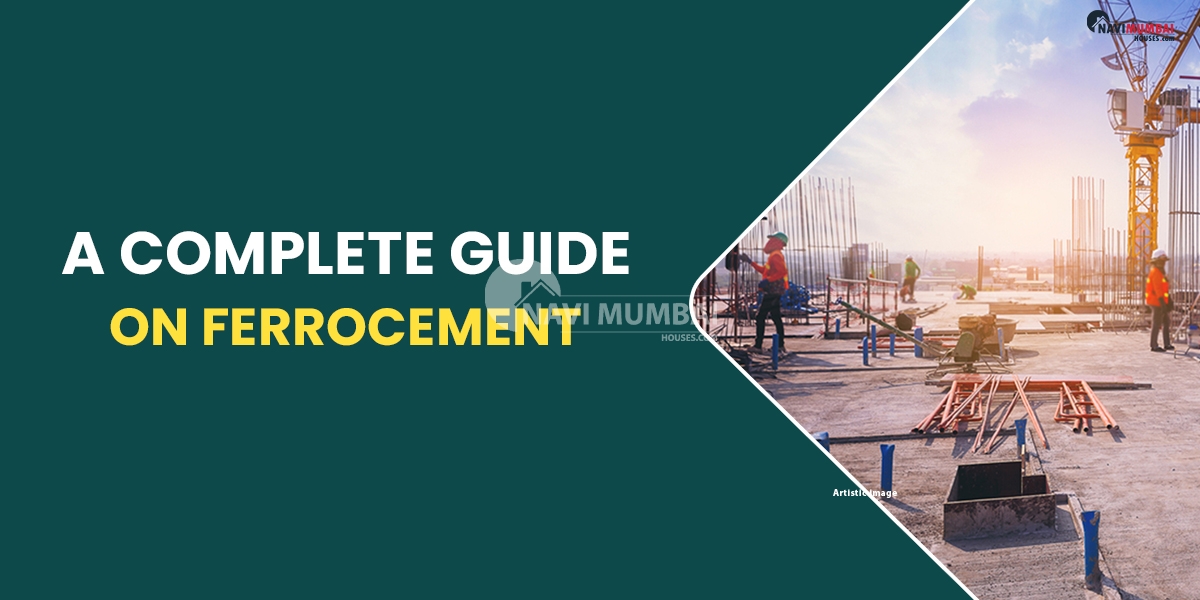
- September 27, 2023
- News
Ferrocement: A Complete Guide To Its Characteristics, Benefits & Price
Complete Guide on Ferrocement- Due to its many advantages, ferrocement, which was created in the 1940s by an Italian architect, is a widely utilised raw material in the construction sector. Ferrocement can be utilised in all construction projects, including new construction and repairs to older ones. This blog provides you with a summary of the main characteristics, uses, benefits, and drawbacks of this material.
Are you searching for new projects in Byculla?
Since its creation, ferrocement has grown in popularity as a building material since it is durable and lightweight. It is made by sandwiching steel mesh or rebar between two layers of cement mortar. The end product is a robust, durable raw material that plays a crucial role in water tanks, shell roofs, and boat hulls. That being stated, continue reading to learn more about the meaning, features, benefits, and cost of ferrocement in India.
Ferrocement: Definition
Ferrocement is a category of building material, namely Reinforced Cement Concrete (RCC), which is made of wire mesh and cement mortar. In the modern building business, ferro cement is quite common due to its low self-weight and the absence of the requirement for experienced labourers or support structures. This substance was create in the 1940s, according to Italian architect. Later, in Act 549 in 1980, the American Concrete Institute standardized the composition and application of ferrocement.
Due to its low maintenance costs and quicker installation time on-site, this material has become more common in the building sector during the past 20 years. Additionally, the components are all produced on the machinery, ensuring higher product quality. Let’s now examine its characteristics.
Ferrocement: Characteristics
The key characteristics of ferrocement are as follows:
- It is a form of reinforced cement concrete that is incredibly adaptable.
- Ferrocement is an essential component of thin reinforced concrete due to the homogeneous application of many wire meshes with small diameters throughout the cross-section.
- Instead of using concrete, the ferrocement mixture is made with Portland cement.
- Typically, metal or another suitable material is utilised to make the mesh that is used with cement mortar.
- The quantity of reinforcing elements and the calibre of the cement mortar used are the two main factors that affect how strong a ferrocement structure is.
Applications for ferrocement
Ferrocement is use in a wide range of modern construction projects, from residential to agricultural. Here are a few of its frequent applications:
- Housing: In addition to building wall panels, permanent formwork, roofing sheets, shelf planks & dome structures, ferrocement is also use to repair and renovate existing structures.
- Sanitation and water supply: It is use to construct septic tanks, sedimentation tanks, swimming pool linings, water tanks, and well casings.
- Agriculture: Ferrocement is use to build structures like silos, grain bins, irrigation channels, and pit linings.
- Energy-related projects: It is an essential component of biogas digesters, solar panels, and incinerators.
Ferrocement: Benefits and Drawbacks
The benefits and drawbacks of ferrocement use are list in the following table:
| Ferrocement: Advantages and disadvantages | |
| Advantages | Disadvantages |
| To operate with this material, skilled personnel is not requires. | Using bolts, screws, welding, and nails to fasten ferrocement constructions is difficult. |
| The essential raw materials required for ferrocement are often accessible. | Structures made of ferro cement are easily pierced by collision with sharp items. |
| Buildings made of ferrocement are often more earthquake-resistant. | The cost of labour is often higher for a ferro cement project. |
| RCC is inferior than ferrocement in terms of how easily it can be moulde into any size or shape. | Because the reinforcing mesh is not entirely cover by mortar, it is vulnerable to corrosion. |
| In the case of ferrocement, the overall cost of raw materials is low. | The process of tying rods with mesh takes time and could lengthen the turnaround. |
| Ferrocement makes building easier, extends the life of structures, and makes them lighter. | Even if specialised labour is not necessary, there is a greater than typical demand for labourers. |
Cost of ferrocement in India
In India, the price of ferro cement varies depending on the quantity needed and the source. Based on the additional taxes imposed on building supplies, it differs from region to region as well. Ferrocement slabs typically cost around Rs 95 per cubic foot. Speak with the contractor and explain your exact needs to get an idea of the total cost associate with the project.
The construction industry favours ferro cement because of its long lifespan and simplicity of construction. Make sure you speak with a qualified building contractor to see whether employing ferro-cement is a viable option for your project.
You’re looking for Projects in Wadala we have the Best Properties In Mumbai Like Ready to Move:https://navimumbaihouses.com/properties/search/wadala/
If you want daily property update details please follow us on Facebook Page / YouTube Channel / Twitter









